Biopsychology
1/149
There's no tags or description
Looks like no tags are added yet.
Name | Mastery | Learn | Test | Matching | Spaced |
|---|
No study sessions yet.
150 Terms
Define: Nervous System
Responsible for collecting, processing, and responding to environmental stimuli, and coordinating the functions of different organs and cells in the body.
Define: Central Nervous System (CNS)
Composed of the brain and spinal cord, responsible for conscious awareness, reflex actions, and processing sensory information.
Define: Peripheral Nervous System (PNS)
Transmits sensory information to the CNS and back via neurons.
Define: Somatic Nervous System (SNS)
A subdivision of the PNS that controls skeletal muscles and reflex actions by transmitting information from sensory organs to the CNS.
Define: Autonomic Nervous System
A subdivision of the PNS that regulates involuntary actions, divided into sympathetic and parasympathetic systems.
Define: Sympathetic Nervous System
Part of the ANS responsible for the body's "fight or flight" response during emergencies.
Define: Parasympathetic Nervous System
Part of the ANS that restores the body to a state of calm after a stressor.
Define: Endocrine System
Works alongside the nervous system to control vital functions through hormones, generally slower than the nervous system.
Define: Gland
Specialised organs which create and release substances such as hormones, sweat, tears etc. Endocrine glands secrete hormones directly into the bloodstream.
Define: Pituitary Gland
The gland that regulates the functions of other endocrine glands.
Define: Adrenal Glands
Glands that produce hormones like cortisol and aldosterone, helping the body manage stress and regulate blood pressure.
Define: Hormone
A chemical substance produced by multicellular organisms that allow different parts of the body to communicate with others.
Define: Fight or Flight Response
The instinctive physiological response to a perceived threatening stressor which readies the one to either forcibly resit or to run away or to freeze. It triggers the SNS.
Define: Adrenaline
A hormone produced by the adrenal glands that increases rates of blood circulation, breathing, and prepares the muscles for exertion.
Define: Neurons
Specialized cells that transmit messages within the nervous system using electrical signals called action potentials.
Define: Sensory Neurons
Neurons that carry sensory information from the senses to the CNS.
Define: Relay Neurons
Neurons that facilitate communication between sensory and motor neurons, primarily found in the CNS.
Define: Motor Neurons
Neurons responsible for transmitting signals from the CNS to muscles and glands. The effectors.
Define: Axon
A long slender projection of a neuron that conducts electrical impulses known as action potential away from the cell body.
Define: Dendrite
A branched extension of a neuron that transmits action potential from one neuron to the cell body (the soma).
Define: Myelin Sheath
An insulating layer that forms around the axon on a neuron.
Define: Nodes of Ranvier
The gaps in the myelin sheath coating. Developed through evolution as it transmits action potential faster.
Define: Terminal Buttons
The small knobs at the end of an axon that release neurotransmitters into the synapse.
Define: Synaptic Transmission
The process by which neurotransmitters are released from one neuron at the terminal knob and bind to receptors on the dendrites of another.
Define: Synaptic Vesicle
A sac filled with a neurotransmitter.
Define: Presynaptic nerve terminal
Where action potential triggers the release of neurotransmitters.
Define: Synaptic Cleft
The space between the axon terminal go one neuron and the dendrite of another.
Define: Postsynaptic receptor sites
Ion channels where neurotransmitters bind to.
Define: Neurotransmitter
A chemical substance which is released by action potential, diffuses across the synaptic cleft, to effect the transfer of the impulse to another neuron.
Define: Excitation
The action of exciting or the state of being excited. Applied to neurotransmitters that are positive and increase the likelihood of the impulse firing.
Define: Inhibition
Hindering or preventing an action. Neurotransmitters that are negative and decrease the likelihood of the impulse firing.
Define: Summation
How a neuron decides whether or not to transfer an impulse depending on the sum of excitatory post-synaptic potential (EPSP) and Inhibitory Post-synaptic potential (IPSP).
Define: Action potential
The impulse which propagates, spreads, along the axon.
Define: Localisation of Function
The principle that specific functions are associated with specific areas of the brain.
Define: Motor Area
Controls voluntary movement, found in both hemispheres but each side controls the muscles on the opposite side of the body.
Define: Somatosensory Area
Processes information from senses relating to pain, pressure, and temperature. It is located in the parietal lobe.
Define: Visual Area
Processes visual information received by the eyes via the optic nerve. It is located in the occipital lobe at the posterior of the brain.
Define: Auditory Area
Processes auditory information in order to make sense of sound and respond to them according. Located in the temporal lobe near each ear.
Define: Broca’s Area
A region in the left hemisphere responsible for speech production.
Define: Wernicke’s Area
A region in the left hemisphere responsible for language comprehension.
Define: Cerebral Cortex
The outermost layer of the cerebrum. It carries out essential functions (thinking, learning, reasoning) and is composed of folded grey-matter to ensure a large surface area.
Define: Neuroplasticity
The brain's ability to change and adapt, functionally and physically, in response to experiences and learning.
Define: Functional Recovery
The brain's ability to transfer functions to other areas after cranial trauma. Secondary neural pathways form redirecting communication whilst maintaining function.
Define: Synaptic Pruning
The process of eliminating underused neurons and strengthening frequently used connections in the brain.
Define: Recruitment of homologous areas
Similar areas of the brain in the opposite hemisphere are ‘recruited’ to preform the function of the damaged area.
Define: Denervation supersensitivity
In order to compensate for the damaged areas, axons with comparable function become supersensitive.
Define: Neural Unmasking
When dormant synapses are activated as a result of damage to the surrounding active neurons.
Define: Axonal Sprouting
New nerve endings form and attach to undamaged nerve endings forming new neural pathways.
Define: Synaptic reweighting
How an active synapse will physically grow (the terminal knobs grow) creating more synaptic vesicles which in turn release more neurotransmitters, more can bind to terminals, increasing action potential.
Define: Cognitive Reserve
The brain’s ability to improvise and find alternative ways of getting a job done. It is the resistance to cranial trauma.
Define: Hemispheric Lateralisation
The functional dominance of one hemisphere, one side, over the other in which one is more or entirely responsible for the control of the function.
Define: Contra-lateral Control
How each side of the brain controls the opposing side of the body.
Define: Split Brain Studies
Research examining the effects of cutting the corpus callosum on brain function and behavior.
Define: Cortical specialisation
Another phrase for ‘ways of investigating the brain.’ Cortical areas are specialised for particular function.
Define: Functional Magnetic Resonance Imaging
A technique to investigate the brain. Blood oxygenation and flow is detected to show which areas are activated.
Define: Haemodynamic Response
The more oxygen needed as a part is used more.
Define: Activation maps
The 3D dynamic maps generated by fMRIs.
Define: Electroencephalogram
A skull cap lined with electrodes to measure action potential of neural firing to show overall brain activity of brainwaves.
Define: Arrhythmic patterns
Irregular and inconsistent graphs of brainwaves.
Define: Event-related Potentials
A technique of cortical specialisation. Brainwaves of an EEG are isolated for specific brainwaves related to certain activity to be examined.
What is the isolated brainwave that occurs due to a stimulus called?
Event-related potential.
Define: Post mortem Examinations
The examination of brains after death.
Define: Neurotypical Brain
Brains which functions in a way that is similar to most people.
Define: Biological Rhythms
Natural rhythmic cycles in life of repetitive biological processes. These are influenced by internal and external factors.
Define: Circadian Rhythm
A biological rhythm that lasts approximately 24 hours. Example: Sleep/wake cycle
Define: Infradian Rhythm
A biological rhythm which lasts longer than 24 hours. Example: Menstrual Cycle
Define: Ultradrain Rhythm
A biological rhythm which occurs more than once in a 24 hour period. Example: Different Stages of Sleep.
Define: Endogenous Pacemakers
Internal mechanisms that govern biological rhythms. Example: The Suprachiasmatic Nucleus
Define: Exogenous Zeitgebers
External cues that regulate and influence biological rhythms. Example: social cues, light.
Define: Sleep/Wake Cycle
A circadian rhythm which refers to the recurring pattern of transitions between sleep and wakefulness. Drowsiness at night and alert during day.
Define: Phrenology
The study of the structure of the skull to determine a person’s character and capacity.
What are the four concentric layers of the human brain?
Central Core, Limbric System, Cerebrum, Cerebral Cortex

What is the name of the light blue region?
Frontal Lobe
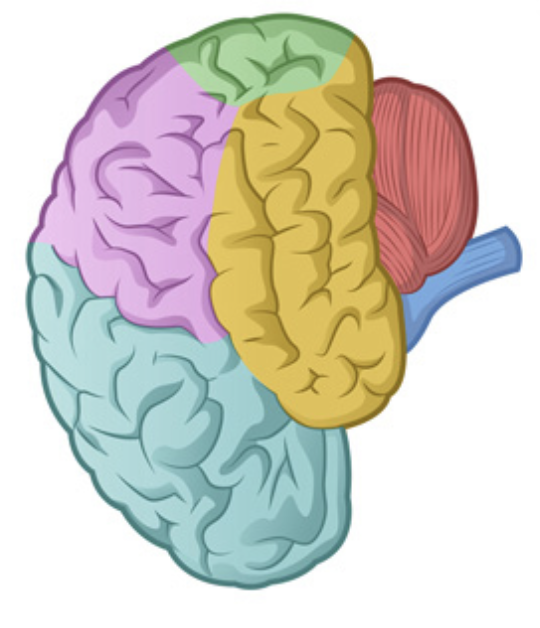
What is the name of the purple region?
Parietal Lobe
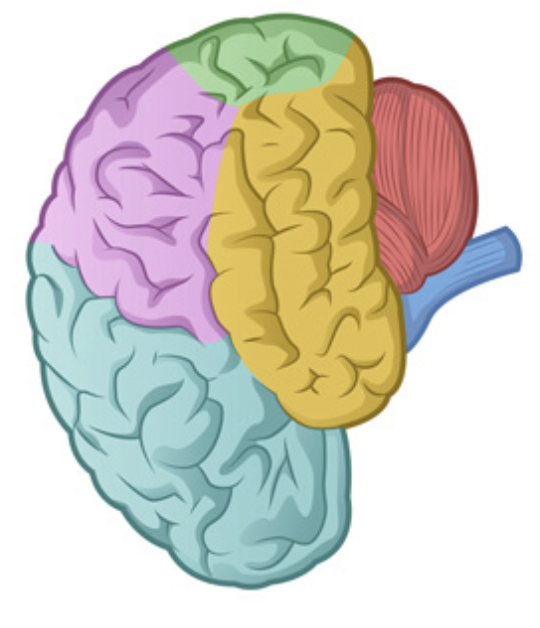
What is the name of the green region?
Occipital Lobe
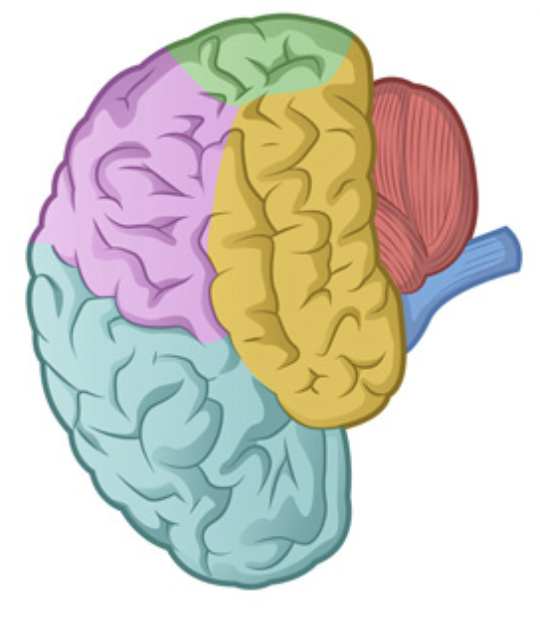
What is the name of the yellow region?
Temporal Lobe
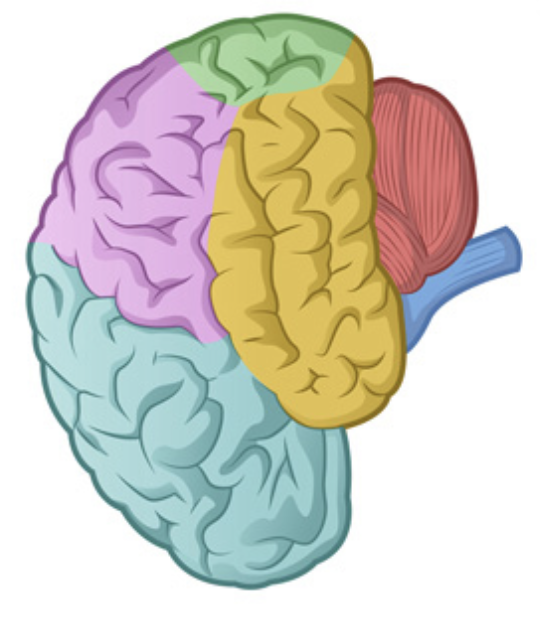
What is the name of the red region?
Cerebellum
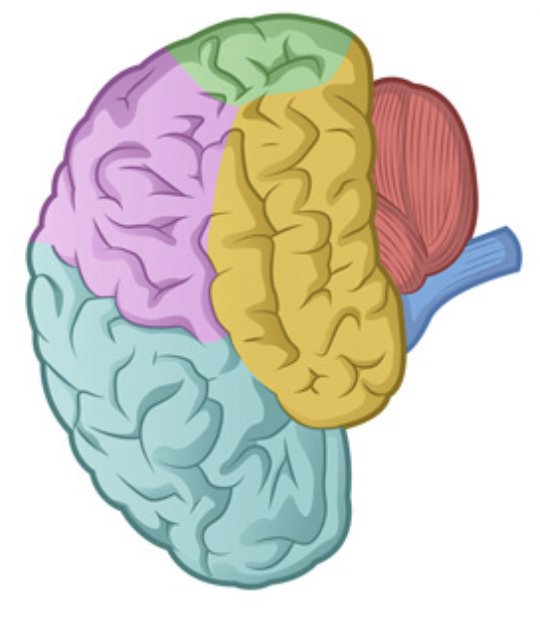
What is the name of the dark blue region?
Brainstem
What is the function of cerebrum and what is its divisions?
Regulates higher intellectual processes. The outermost layer is the cerebral cortex, it is divided into the left and right hemispheres, which is further divided into the four lobes.
How are the two hemispheres connected?
By a bundle of approximately 250 million axons fibres called the corpus callosum.
What is Broca’s Aphasia?
Damage to the area responsible for speech generation resulting in difficulty to formulate a full sentence.
What is Wernicke’s Aphasia?
Damage to the area responsible for comprehension of speech resulting in difficulty producing language and understanding it.
Localisation of Brain Function: Peterson (1988)
Brain scans demonstrated how Wernicke’s Area was active during listening tasks whereas Broca’s area was active during reading. Suggesting these areas perform specific functions.
Localisation of Brain Function: Tulving et al (1994)
Brain scanning (Tulving’s Gold Study) showed that semantic and episodic memory reside in separate parts of the brain.
Localisation of Brain Function: Dick and Tremblay (2016)
CP - showed language neural processes occur in all parts of the brain in some way.
Localisation of Brain Function: Counter Theory
Karl Lashley (1950) suggested that the basic motor and sensory functions were localised but higher mental functions are not.
Localisation of Brain Function: Karl Lashley’s Theory
Equipotentiality Theory
Localisation of Brain Function: Karl Lashley’s Animal study
He found that removal of anything up to 50% of a rat’s brain had no impact on its ability to learn and to run a maze. Higher mental functions such as learning, memory were distributed more globally.
Localisation of Brain Function: Phineas Gage (Prefrontal Cortex)
Damasio et al (1994) concluded that functions such as decision making, personality expression, moderating social behaviour, and future planning are located in the prefrontal cortex.
Localisation of Brain Function: Phineas Gage (Basic Functions)
Other functions such as motor control, speech, and vision are located not in the prefrontal cortex as these were not impacted by the iron rod.
Counterpoints to Phineas Gage: Case Studies
Lacks generalisability, does not show causation, lacks replicability.
Phineas Gage: Case Studies Support
Verified accounts of his personality means that PG can show causation unlike most case studies.
Phineas Gage: Case Studies Limitation
Cannot determine whether the change in personality was solely due to the injury. It cannot be determined that the change in lifestyle, his face, and the general trauma did not cause the change in personality.
What is the difference between lobotomy and leucotomy?
Lobotomy is the removal of brain tissue, whereas leucotomy is cutting connections to particular parts of the brain.
What does the success of neurosurgery show? (Dougherty et al, 2002)
The success of these procedures strongly suggests that symptoms and behaviours associated with serious mental disorders are localised.
Neuroplasticity: Maguire et al (2000)
Studied the brains of London taxi drivers using an MRI and found that the hippocampus had changed significantly physically compared to the matched control. Suggesting navigational and spatial skills.
Neuroplasticity: Gopnick et al (1999)
Infants have enormous growth in the number of synaptic connections in their brain, up to 15000 synaptic connections per neuron, this halves by adulthood.
Neuroplasticity: Draganski et al (2006)
Medical students showed changes to their posterior hippocampus and their parietal cortex following their final exams.
Neuroplasticity: Mechelli et al (2004)
Bilingual people have a larger parietal cortex than monolingual people.
Neuroplasticity: Maguire et al (2002) Strength
Uses scientific objective measurements. MRI scans show empirical evidence of structural change. Study uses a control group allowing significant difference to be established.